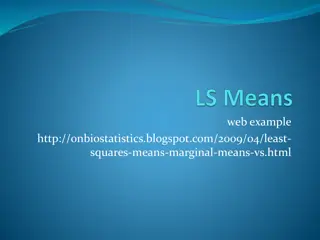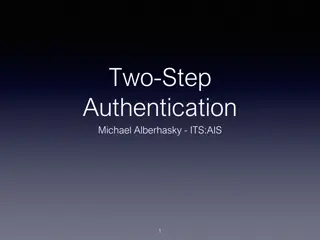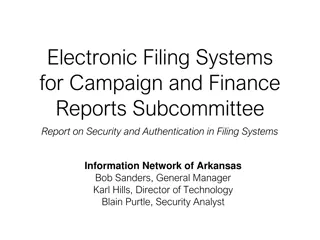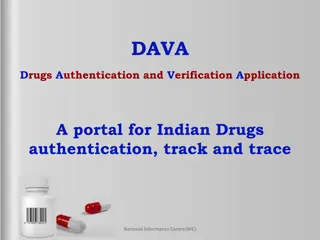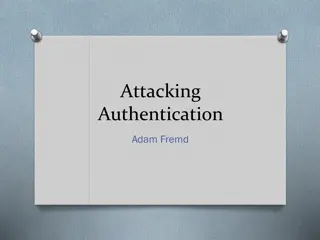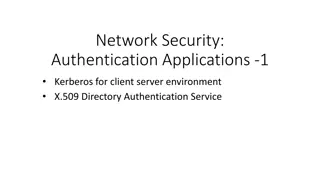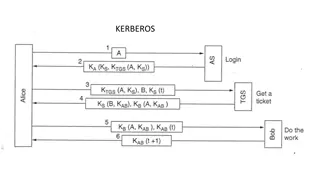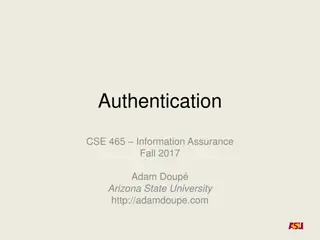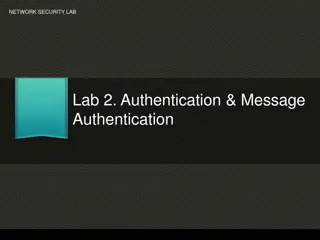Authentication Overview: Definition and Means
The essential concepts of authentication, including its definition, means, steps, and types like password-based and token-based authentication. Learn about the importance of identification and verification in securing access to systems and the various factors involved in authentication methods."
Download Presentation

Please find below an Image/Link to download the presentation.
The content on the website is provided AS IS for your information and personal use only. It may not be sold, licensed, or shared on other websites without obtaining consent from the author.If you encounter any issues during the download, it is possible that the publisher has removed the file from their server.
You are allowed to download the files provided on this website for personal or commercial use, subject to the condition that they are used lawfully. All files are the property of their respective owners.
The content on the website is provided AS IS for your information and personal use only. It may not be sold, licensed, or shared on other websites without obtaining consent from the author.
E N D
Presentation Transcript
Johann Felix Conceicao 411106 Te Comp
Outline Definition Steps in Authentication Means of Authentication Password Authentication Token-Based Authentication Biometrics
Definition What is Authentication? General: Verification of the genuineness of a documentorsignature, to make iteffectiveorvalid. Computeraccess: Verification of the identityof a userthrough a code such as a password.
Authentication consist of two steps Identification Step: Presenting an identifier to the security system. Verification Step: Generate authentication information which provides binding between the entity and the identifier.
Means of Authentication Something the individual knows. Eg: Password 1. 2. Something the individual possesses. Eg: Smart Cards, Physical Keys.(Token Based ) Something the individual is. Eg: Fingerprints, Face. (Static Biometrics) 4. Something the individual does. Eg: Signature (handwriting char.),Voice patterns. (Dynamic Biometrics) 3.
Password Based Authentication Setup User chooses password Hash of password stored in password file Authentication User logs into system, supplies password System computes hash, compares to file
Basic password scheme Hash function h : strings strings User password stored as h(password) in password file When user enters password System computes h(password) Compares with entry in password file If password entered by user is equal to password from password file, then user is authenticated. Else it gives an error saying that username or password is incorrect.
Basic password scheme User Password file kiwifruit exrygbzyf kgnosfix ggjoklbsz hash function
Token Based Authentication Objects that a user possesses for the purpose of user authentication are called tokens (security tokens). Security tokens are used to prove one's identity electronically (eg: Customer s trying to access their bank account). Thus it acts like an electronic key to access something. It is a small hardware device that the owner carries to authorize access to a network service. The device may be in the form of a smart card or may be embedded in a commonly used object such as a key fob.
Conti.. Security tokens provide an extra level of assurance through a method known as two-factor authentication: the user has a personal identification number (PIN), which authorizes them as the owner of that particular device; the device then displays a number which uniquely identifies the user to the service, allowing them to log in. Unlike a password, a security token is a physical object. A key fob, for example, is practical and easy to carry, and thus, easy for the user to protect. Even if the key fob falls into the wrong hands, however, it can't be used to gain access because the PIN (which only the rightful user knows) is also needed.
Biometric Authentication A biometric authentication system attempts to authenticate an individual based on his or her unique physical characteristics. Individuals characteristics can be static characteristics (fingerprints, hand geometry, facial characteristics, and retinal and iris patterns) and dynamic characteristics (voiceprint and signature). Advantages: Cannot be disclosed, lost, forgotten Disadvantages: Cost, installation, maintenance
Biometrics Physiological Iris Fingerprint (including nail) Hand (including knuckle, palm, vascular) Face Voice Retina DNA Even Odor, Earlobe, Sweat pore, Lips Behavioral (patterns) Signature Keystroke Voice
Physiological Biometrics Fingerprints: A fingerprint is the pattern of ridges on the surface of the fingertip. Two premises for fingerprint identification Fingerprint details are permanent Fingerprints are unique Face: Facial characteristics are the most common means of human-to-human identification. We can define characteristics based on relative location and shape of key facial features, such as eyes eyebrows, nose, lips, and chin shape.
Physiological Biometrics Retinal Pattern: The pattern formed by veins beneath the retinal surface is unique and therefore suitable for identification. Hand: Hand geometry systems identify features of the hand, including shape, and lengths and widths of fingers. Iris: The detailed structure of the iris also a unique physical characteristic in authentication.
Behavioral Biometrics Signature: Each individual has a unique style of handwriting, and this is reflected especially in the signature, which is typically a frequently written sequence. However, multiple signature samples from a single individual will not be identical. This complicates the task of developing a computer representation of the signature that can be matched to future samples.
Behavioral Biometrics Voice: Voice patterns are more closely tied to the physical and anatomical characteristics of the speaker. There is still a variation from sample to sample over time from the same speaker, complicating the biometric recognition task.
References Operating Systems by William Stallings page no: 668-669, 672-675
Questions Explain Password Protection Technique. Write a short note on Biometrics What are the four means of authentication? Explain with examples.









